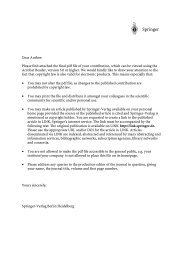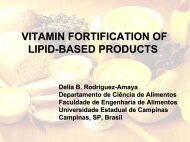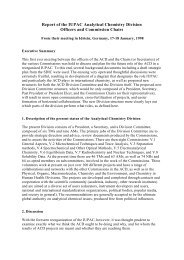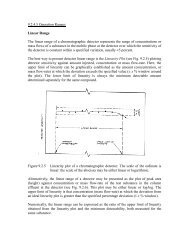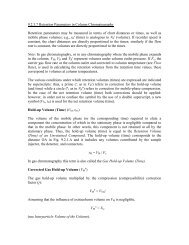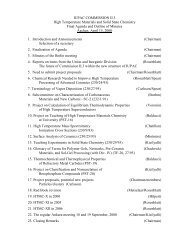pdf file - 297KB - IUPAC
pdf file - 297KB - IUPAC
pdf file - 297KB - IUPAC
You also want an ePaper? Increase the reach of your titles
YUMPU automatically turns print PDFs into web optimized ePapers that Google loves.
Michelle N. Chrétien Ph. D.<br />
NSERC Post-doctoral Fellow<br />
CONCORDIA UNIVERSITY • DEPARTMENT OF CHEMISTRY AND BIOCHEMISTRY<br />
• 7141 SHERBROOKE STREET WEST • MONTRÉAL, QC, H4B 1R6 • (514) 848-2424<br />
x5324 • EMAIL: mnchreti@vax2.concordia.ca<br />
ESSAY<br />
Zeolites are inorganic solids that are closely related to the soil, sand, minerals,<br />
and clays that make up much of the earth around us. Zeolites are nanoporous,<br />
crystalline aluminosilicate materials and their tertiary structure forms a series of strictly<br />
uniform channels and cavities of molecular dimensions that are repeated along the tri-<br />
directional structure of the lattice.<br />
Figure 1. Representation of the [SiO4] 4- and [AlO4] 5- tetrahedra that are the primary building blocks of<br />
zeolites, as well as the sodalite periodic building unit and zeolites A, X, and Y.<br />
Although the use of zeolites in crude oil conversion and detergent formulations<br />
has been extensively studied over the past four decades, the interest of photochemists in<br />
zeolites as host systems for supramolecular photochemistry is relatively recent. Zeolites<br />
have emerged as convenient and versatile solid hosts for the control of photochemical<br />
and photophysical processes. At the time of initiating graduate studies I was very<br />
interested in exploiting zeolites, which are inexpensive and readily available, to prepare<br />
new materials having interesting and valuable properties. Accordingly, I became<br />
1
Michelle N. Chrétien<br />
involved in several projects exploring the photochemical and photophysical properties<br />
of new materials, prepared by the encapsulation of organic or organometallic species<br />
within the cavities of aluminosilicate zeolites. Along the way we have examined<br />
different facets of intrazeolite photochemistry with the additional aim of developing a<br />
more profound understanding of how zeolite media can influence the behaviour of<br />
encapsulated guests.<br />
Our research in the area of zeolite photocatalysis was inspired by the profoundly<br />
important need for efficient and economical methodologies for the purification of<br />
drinking water. In 2004, UNICEF estimated that over one billion people were still<br />
without access to sanitary drinking water. The rate of natural biological remediation is<br />
surpassed by the quantity of waste released into the system and the vulnerability of<br />
global fresh water resources is becoming increasingly apparent. To cope with the<br />
effects of pollution on the hydrosphere, the development of treatment methodologies<br />
based on efficient catalytic materials has become increasingly important.<br />
Photocatalysts are superior to thermal catalysts in many respects, however, there<br />
are still several disadvantages associated with the use of traditional photocatalysts for<br />
large-scale remediation. For example, TiO2, a popular heterogeneous catalyst for<br />
wastewater purification does not have significant absorption beyond 370 nm therefore<br />
requiring UV light for efficient photodegradation. The advantages of alternative<br />
photocatalytic systems operating under visible-light illumination are obvious. We have<br />
designed zeolite-based photocatalytic materials by taking advantage of the zeolite<br />
framework to prepare a multi-component system comprising a semiconducting oxide<br />
and an electron-accepting or –donating dye.<br />
Ultraviolet irradiation of TiO2 results in the generation of reactive oxygen<br />
species, ultimately causing the photodegradation of various biological and organic<br />
materials. To harness solar energy more efficiently, the zeolite matrix was used to<br />
combine TiO2 with a highly-coloured dye in order to produce the same reactive species<br />
via a visible-light-induced, electron transfer interaction. The electron transfer nature of<br />
the interaction in these materials was thoroughly characterized by steady-state and<br />
time-resolved spectroscopy and the catalytic behaviour was examined with respect to
Michelle N. Chrétien<br />
the photodegradation of a model biological substrate. We observed that our material<br />
combining TiO2 and 2,4,6-triphenylpyrilium was more active than TiO2 anatase, a<br />
popular commercial photocatalyst. The development of water-purification catalysts for<br />
use in combination with solar radiation is an important direction in the pursuit of an<br />
economically viable solution for wastewater remediation.<br />
Ru 2+ (bpy) 3<br />
TP TiO 2<br />
hν<br />
TiO 2 Ru 3+ (bpy) 3 TiO 2/e CB<br />
hν<br />
TP TiO 2/h VB<br />
Figure 2. The products of photoinduced electron transfer between TiO2 and the two dyes, tris(2,2’bipyridine)ruthenium(II)<br />
and 2,4,6-triphenylpyrylium cation.<br />
In the course of our research, zeolite materials have also been used in a more<br />
traditional sense as matrices for the stabilization of various transient or reactive species.<br />
In our investigation of the photochemistry of ketoprofen (a non-steroidal anti-<br />
inflammatory drug), this drug was observed to undergo an intrazeolite<br />
photodecarboxylation to generate a benzylic carbanion. The lifetime of the zeolite-<br />
encapsulated carbanion was found to be fifty times longer than in aqueous solution!<br />
This provided the first example of a carbanionic species stabilized by zeolite<br />
encapsulation, disabusing the widely accepted notion that zeolites are ineffective hosts<br />
for reactive, negatively-charged species.<br />
O<br />
O Si<br />
O<br />
O<br />
Al<br />
O<br />
O<br />
O Si<br />
O<br />
O<br />
O Na +<br />
Figure 3. Schematic representation of a possible carbanion stabilization mode in NaY.<br />
The enhanced lifetime allows intermolecular nucleophilic addition chemistry to<br />
compete with protonation, the dominant reaction in aqueous solvents, and a photo-<br />
O
Michelle N. Chrétien<br />
initiated, carbon-carbon bond forming reaction was observed. In addition, the<br />
observation of nucleophilic addition products from the irradiation of ketoprofen in the<br />
presence of various nucleophiles supports the assignment of this reactive intermediate<br />
as the ground state singlet carbanion. The nature of this intermediate cannot be<br />
uniquely confirmed spectroscopically and its identity and has been contested in the<br />
literature in the past.<br />
We have also investigated the feasibility of elaborating traditional sunscreens<br />
based on the novel concept of encapsulation, this work was aimed at preventing the<br />
side-effects that are common with many commercial sunscreens. Significant evidence<br />
exists that over-exposure to solar radiation has a negative impact on human health.<br />
Skin cancer is the most commonly occurring cancer in Canada, accounting for one third<br />
of all newly diagnosed cancers and over one million people in Canada and the USA are<br />
diagnosed with melanoma, basal cell, and squamous cell cancers each year.<br />
With increased awareness of the relationship between radiation exposure and<br />
skin cancer, the use of sunscreens has exploded. Sunscreens have become ubiquitous,<br />
appearing in a surprising number of products ranging from shampoo to lipstick. With<br />
this increase in usage has come an accompanying increase in the reported occurrences<br />
of photoallergy and phototoxicity; it is currently estimated that ca. 20% of the<br />
population are photosensitive to one or more sunscreen active ingredients.<br />
Increasing reports of photosensitivity, and commercial formulations containing<br />
mixtures of components whose interactions are largely uninvestigated, pushed us to<br />
pursue a solution to problems associated with current commercial sunscreens. We<br />
reasoned that encapsulation of sunscreen active ingredients in a suitable host might<br />
effectively prevent interaction with biological substrates, while at the same time<br />
preserving the desirable scattering/absorbing properties of the filter. Through zeolite<br />
encapsulation we hoped to obtain a supramolecular sunscreen that would retain the<br />
beneficial characteristics of the parent sunscreen but prevent photosensitivity by<br />
eliminating contact between sunscreens and skin components, as well as eliminating<br />
interaction between ingredients.
Michelle N. Chrétien<br />
There are numerous intrinsic advantages to this strategy. The aluminosilicate<br />
framework is transparent in the mid-UV, enabling the encapsulated sunscreen to absorb<br />
radiation and, due to the particulate nature of zeolites, the supramolecular sunscreens<br />
will act as light scatterers, eliminating the need for semi-conductor oxides (which are<br />
employed with increasing frequency) in topically applied products .<br />
In the course of this work several important aspects of sunscreen photochemistry<br />
were brought to light. We have shown that the common combination of metal oxide<br />
scatterers with soluble organic absorbers results in the light-induced destruction of the<br />
latter. Surprisingly, this process was accelerated in the presence of surfactants, which<br />
are commonly considered “non-active” ingredients in sunscreen formulations. Also<br />
surprisingly, in light of their solution photostability, several popular sunscreens were<br />
observed to induce cell mortality and DNA damage in human skin cells. Encapsulation<br />
of sunscreens in zeolites prevented the metal oxide-induced photodegradation as well<br />
as the deleterious effects with respect to human skin cells while offering photo-<br />
protection that is comparable to classical or “naked” sunscreens.<br />
OCT<br />
OXB<br />
OMC<br />
OSA<br />
Cocktail<br />
0 5 10 15<br />
Apparent SPF<br />
Figure 4. In vitro SPF values determined using the Labsphere UTA for equivalent amounts of five popular free<br />
(stripes) and encapsulated (grey) sunscreens suspended in ethylene glycol. The cocktail contained equal amounts of<br />
all four free or encapsulated sunscreens.<br />
In total, our work represents a significant contribution to the general area of<br />
supramolecular photochemistry while at the same time providing new materials that<br />
may, hopefully, contribute to improving human health.





